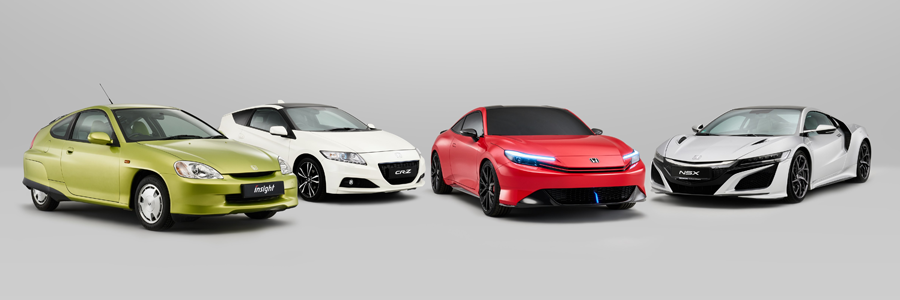Honda celebrates 25 years of hybrid performance

This year - 2024 - marks something of a milestone for Honda. In 1946, Soichiro Honda founded a small company building motorised bicycles using surplus generator engines left over after the end of WWII. In just four short years, Honda grew the company he founded from a small workshop in a wooden shack to operating its own full-scale manufacturing plant producing the engines for its first proper motorcycle, the D-Type.
Building on its founder’s vision and innovative engine designs, the newly-rebranded Honda Motor Company continued to grow into the globally-recognised automotive giant it is today.
For a brand that essentially began as an engine manufacturer, it’s no surprise that Honda has been at the forefront of engine design and technology for almost 80 years. Which makes it equally unsurprising that 2024 marks 25 years since Honda introduced the European market to its first petrol-electric hybrid model, the Honda Insight.
With its extensive history in engine design and production, Honda spent decades applying that expertise to the development of ever-cleaner and more efficient petrol engines. As awareness of the environmental impact of vehicle pollution began to grow in the late 80s and early 90s, Honda took the decision to focus its research on petrol-electric hybrid technology with the aim of producing the most efficient vehicle in the world.
When Honda launched the Insight back in 1999, the brand’s first production petrol-electric vehicle boasted a unique Integrated Motor Assist (IMA) hybrid system that could deliver combined fuel consumption figures of 83mpg. That was a level of fuel efficiency simply unheard of at the time.
In the 25 years since that first hybrid model was launched, the brand’s engineers have been honing and developing the technology even further, developing various hybrid architectures for different applications. In addition to that first IMA hybrid system, these include the two-motor intelligent Multi Mode Drive (i-MMD) system that is fitted across Honda’s current e:HEV range, and the three-motor Super Handling All-Wheel Drive (SH-AWD) system in the 573bhp second-generation NSX.
Honda and Formula 1
The ultimate test of Honda’s hybrid technology came with its return to Formula 1 at the beginning of the turbo-hybrid era.
Honda had surprised everyone when it announced the end of its hugely successful association with F1 on the eve of the 2009 season due to the global financial crisis. Almost as surprising was Honda’s return to the pinnacle of motorsport in 2015, first as engine supplier to McLaren before a switch to Red Bull in 2019.
Honda’s continuous refinement of its hybrid power unit helped Max Verstappen clinch his first driver’s championship in 2021 – the first Honda-powered world champion since Ayrton Senna clinched his third, and tragically final, title in 1991. Although Honda officially stepped back from F1 in 2021 to concentrate on carbon-neutral technologies, its engines continued to power Red Bull to consecutive victories in both driver and constructor championships in 2022 and 2023. The current deal sees Honda continue as engine supplier to Red Bull until 2025, ahead of its full-scale return to the sport partnering Aston Martin for the 2026 season.
Honda has always been at the forefront of hybrid technology, and over the past 25 years it has continued to refine and improve its efficient hybrid drivetrains on both road and racetrack.
The results of all that effort and experience can now be seen in the current crop of fully-electrified mainstream models – namely the Jazz, Civic, HR-V, CR-V, and the brand-new ZR-V range. And that’s the reason why leasing yourself a hybrid Honda is never going to be a bad decision.
View our latest blog posts

Categories
Pages
We are a family run business based in rural Worcestershire. Our team of 38 staff are on hand to provide an exceptional service to personal and business customers.
Read More
